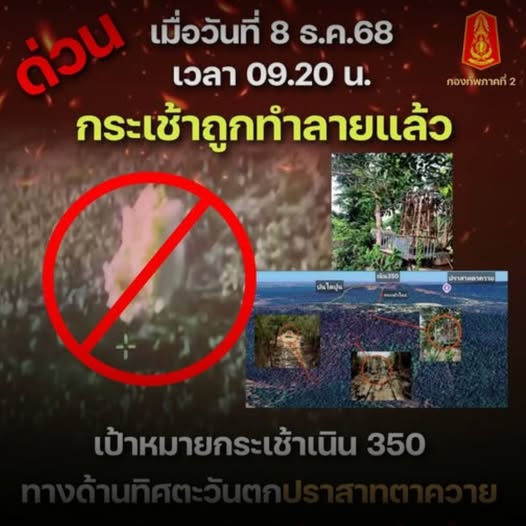รวมข่าวจากเวบ SecurityOnline
#รวมข่าวIT #20251218 #securityonline
Mozilla เปิดยุคใหม่: Firefox เตรียมกลายเป็นเบราว์เซอร์พลัง AI
Mozilla ประกาศแผนการใหญ่ภายใต้การนำของ CEO คนใหม่ Anthony Enzor-DeMeo ที่จะเปลี่ยน Firefox จากเบราว์เซอร์แบบดั้งเดิมให้กลายเป็นแพลตฟอร์มที่ขับเคลื่อนด้วย AI จุดมุ่งหมายคือการทำให้ Firefox ไม่ใช่แค่เครื่องมือท่องเว็บ แต่เป็นผู้ช่วยอัจฉริยะที่เข้าใจผู้ใช้และสามารถปรับแต่งประสบการณ์ออนไลน์ได้อย่างลึกซึ้ง การเปลี่ยนแปลงนี้สะท้อนถึงความพยายามของ Mozilla ที่จะกลับมาแข่งขันในตลาดเบราว์เซอร์ที่ถูกครอบงำโดย Chrome และ Edge
https://securityonline.info/mozillas-new-chapter-ceo-anthony-enzor-demeo-to-transform-firefox-into-an-ai-powered-powerhouse
Let’s Encrypt ปรับระบบ TLS ใหม่: ใบรับรองสั้นลงเหลือ 45 วัน
Let’s Encrypt ประกาศการเปลี่ยนแปลงครั้งใหญ่ในระบบการออกใบรับรอง TLS โดยลดอายุการใช้งานจาก 90 วันเหลือเพียง 45 วัน พร้อมเปิดตัวโครงสร้างใหม่ที่เรียกว่า Generation Y Hierarchy และการรองรับ TLS แบบใช้ IP โดยตรง การเปลี่ยนแปลงนี้มีเป้าหมายเพื่อเพิ่มความปลอดภัย ลดความเสี่ยงจากใบรับรองที่ถูกขโมยหรือไม่ได้อัปเดต และทำให้ระบบอินเทอร์เน็ตมีความยืดหยุ่นมากขึ้น แม้จะเพิ่มภาระให้ผู้ดูแลระบบ แต่ก็ถือเป็นก้าวสำคัญในการยกระดับมาตรฐานความปลอดภัยของเว็บทั่วโลก
https://securityonline.info/the-45-day-era-begins-lets-encrypt-unveils-generation-y-hierarchy-and-ip-based-tls
ช่องโหว่ร้ายแรงใน Apache Commons Text เสี่ยงถูกยึดเซิร์ฟเวอร์
เรื่องนี้เป็นการค้นพบช่องโหว่ใหม่ในไลบรารี Java ที่ชื่อ Apache Commons Text ซึ่งถูกใช้อย่างแพร่หลายในการจัดการข้อความ ช่องโหว่นี้ถูกระบุว่า CVE-2025-46295 และมีคะแนนความรุนแรงสูงถึง 9.8 เต็ม 10 จุดอันตรายอยู่ที่ฟังก์ชัน string interpolation ที่เปิดช่องให้ผู้โจมตีสามารถส่งข้อมูลที่ไม่ปลอดภัยเข้ามาและทำให้เกิดการรันคำสั่งจากระยะไกลได้ ลักษณะนี้คล้ายกับเหตุการณ์ Log4Shell ที่เคยสร้างความเสียหายใหญ่ในอดีต ทีมพัฒนา FileMaker Server ได้รีบแก้ไขโดยอัปเดตเป็นเวอร์ชันใหม่ที่ปลอดภัยแล้ว และแนะนำให้ผู้ดูแลระบบรีบอัปเดตทันทีเพื่อปิดช่องโหว่
https://securityonline.info/cve-2025-46295-cvss-9-8-critical-apache-commons-text-flaw-risks-total-server-takeover
หลอกด้วยใบสั่งจราจรปลอม: แอป RTO Challan ดูดข้อมูลและเงิน
ในอินเดียมีการโจมตีใหม่ที่ใช้ความกลัวการโดนใบสั่งจราจรมาเป็นเครื่องมือ หลอกให้ผู้ใช้ดาวน์โหลดแอป “RTO Challan” ผ่าน WhatsApp โดยอ้างว่าเป็นแอปทางการเพื่อดูหลักฐานการกระทำผิด แต่แท้จริงแล้วเป็นมัลแวร์ที่ซ่อนตัวและสร้าง VPN ปลอมเพื่อส่งข้อมูลออกไปโดยไม่ถูกตรวจจับ มันสามารถขโมยข้อมูลส่วนตัว ตั้งแต่บัตร Aadhaar, PAN ไปจนถึงข้อมูลธนาคาร และยังหลอกให้ผู้ใช้กรอกข้อมูลบัตรเครดิตพร้อมรหัส PIN เพื่อทำธุรกรรมปลอมแบบเรียลไทม์ ถือเป็นการโจมตีที่ผสมผสานทั้งวิศวกรรมสังคมและเทคนิคขั้นสูง ผู้ใช้ถูกเตือนให้ระวังข้อความจากเบอร์แปลกและไม่ดาวน์โหลดแอปจากลิงก์ที่ไม่น่าเชื่อถือ
https://securityonline.info/rto-challan-scam-how-a-fake-traffic-ticket-and-a-malicious-vpn-can-drain-your-bank-account
Node.js systeminformation พบช่องโหว่เสี่ยง RCE บน Windows
ไลบรารีชื่อดัง systeminformation ที่ถูกดาวน์โหลดกว่า 16 ล้านครั้งต่อเดือน ถูกพบช่องโหว่ร้ายแรง CVE-2025-68154 โดยเฉพาะบน Windows ฟังก์ชัน fsSize() ที่ใช้ตรวจสอบขนาดดิสก์ไม่ได้กรองข้อมูลอินพุต ทำให้ผู้โจมตีสามารถใส่คำสั่ง PowerShell แทนตัวอักษรไดรฟ์ และรันคำสั่งอันตรายได้ทันที ผลกระทบคือการเข้าควบคุมระบบ อ่านข้อมูลลับ หรือแม้กระทั่งปล่อย ransomware นักพัฒนาถูกแนะนำให้อัปเดตเป็นเวอร์ชัน 5.27.14 ที่แก้ไขแล้วโดยด่วน
https://securityonline.info/node-js-alert-systeminformation-flaw-risks-windows-rce-for-16m-monthly-users
OpenAI เจรจา Amazon ขอทุนเพิ่ม 10 พันล้าน พร้อมเงื่อนไขใช้ชิป AI ของ Amazon
มีรายงานว่า OpenAI กำลังเจรจากับ Amazon เพื่อระดมทุนมหาศาลถึง 10 พันล้านดอลลาร์ โดยมีเงื่อนไขสำคัญคือ OpenAI ต้องใช้ชิป AI ของ Amazon เช่น Trainium และ Inferentia แทนการพึ่งพา NVIDIA ที่ราคาแพงและขาดตลาด หากดีลนี้เกิดขึ้นจริงจะเป็นการพลิกเกมครั้งใหญ่ เพราะจะทำให้ Amazon ได้การยืนยันคุณภาพชิปจากผู้เล่นรายใหญ่ที่สุดในวงการ AI และยังช่วยให้ OpenAI ลดต้นทุนการประมวลผล ขณะเดียวกันก็สร้างสมดุลระหว่าง Microsoft และ Amazon ในการเป็นพันธมิตรด้านคลาวด์
https://securityonline.info/the-10b-pivot-openai-in-talks-for-massive-amazon-funding-but-theres-a-silicon-catch
Cloudflare เผยรายงานปี 2025: สงครามบอท AI และการจราจรอินเทอร์เน็ตพุ่ง 19%
รายงานประจำปีของ Cloudflare ชี้ให้เห็นว่าปี 2025 อินเทอร์เน็ตกำลังเปลี่ยนแปลงครั้งใหญ่ ปริมาณการใช้งานเพิ่มขึ้น 19% และเกิด “สงครามบอท AI” ที่แข่งขันกันเก็บข้อมูลออนไลน์ โดย Google ครองอันดับหนึ่งด้านการเก็บข้อมูลผ่าน crawler เพื่อใช้ฝึกโมเดล AI อย่าง Gemini ขณะเดียวกันองค์กรไม่แสวงหากำไรกลับกลายเป็นเป้าหมายโจมตีไซเบอร์มากที่สุด เนื่องจากมีข้อมูลอ่อนไหวแต่ขาดทรัพยากรป้องกัน รายงานยังระบุว่ามีการโจมตี DDoS ครั้งใหญ่กว่า 25 ครั้งในปีเดียว และครึ่งหนึ่งของการหยุดชะงักอินเทอร์เน็ตทั่วโลกเกิดจากการกระทำของรัฐบาล การเปลี่ยนแปลงนี้สะท้อนทั้งความก้าวหน้าและความเปราะบางของโลกออนไลน์
https://securityonline.info/the-internet-rewired-cloudflare-2025-review-unveils-the-ai-bot-war-and-a-19-traffic-surge
Locked Out of the Cloud: เมื่อแฮกเกอร์ใช้ AWS Termination Protection ปล้นพลังประมวลผลไปขุดคริปโต
เรื่องนี้เป็นการโจมตีที่ซับซ้อนมากในโลกคลาวด์ แฮกเกอร์เจาะเข้ามาในระบบ AWS โดยใช้บัญชีที่ถูกขโมย แล้วรีบ deploy เครื่องขุดคริปโตภายในเวลาไม่ถึง 10 นาที จุดที่น่ากลัวคือพวกเขาใช้ฟีเจอร์ DryRun เพื่อตรวจสอบสิทธิ์โดยไม่ทิ้งร่องรอย และเมื่อเครื่องขุดถูกสร้างขึ้น พวกเขาเปิดการป้องกันการลบ (termination protection) ทำให้เจ้าของระบบไม่สามารถลบเครื่องได้ทันที ต้องปิดการป้องกันก่อนถึงจะจัดการได้ นั่นทำให้แฮกเกอร์มีเวลาขุดคริปโตเพิ่มขึ้น นอกจากนี้ยังมีการสร้าง backdoor ผ่าน AWS Lambda และเตรียมใช้ Amazon SES เพื่อส่งอีเมลฟิชชิ่งต่อไป เหตุการณ์นี้ไม่ใช่การเจาะ AWS โดยตรง แต่เป็นการใช้ credential ที่ถูกขโมยไปอย่างชาญฉลาด
https://securityonline.info/locked-out-of-the-cloud-hackers-use-aws-termination-protection-to-hijack-ecs-for-unstoppable-crypto-mining
Blurred Deception: กลยุทธ์ฟิชชิ่งของกลุ่ม APT
รัสเซียที่ใช้ “เอกสารเบลอ” กลุ่ม APT จากรัสเซียส่งอีเมลปลอมในชื่อคำสั่งจากประธานาธิบดี Transnistria โดยแนบไฟล์ที่ดูเหมือนเอกสารทางการ แต่เนื้อหาถูกทำให้เบลอด้วย CSS filter ผู้รับจึงต้องใส่อีเมลและรหัสผ่านเพื่อ “ปลดล็อก” เอกสาร ซึ่งจริง ๆ แล้วเป็นการหลอกขโมยข้อมูลเข้าสู่ระบบ ฟังก์ชัน JavaScript ที่ใช้ยังมีลูกเล่นคือไม่ว่ารหัสผ่านจะถูกหรือผิดก็ถูกส่งไปยังเซิร์ฟเวอร์ของแฮกเกอร์อยู่ดี แคมเปญนี้ไม่ได้หยุดแค่ Transnistria แต่ยังขยายไปยังประเทศในยุโรปตะวันออกและหน่วยงาน NATO ด้วย ถือเป็นการโจมตีที่ใช้ความเร่งด่วนและความอยากรู้อยากเห็นของเหยื่อเป็นตัวล่อ
https://securityonline.info/blurred-deception-russian-apt-targets-transnistria-and-nato-with-high-pressure-phishing-lures
“Better Auth” Framework Alert: ช่องโหว่ Double-Slash ที่ทำให้ระบบป้องกันพัง
มีการค้นพบช่องโหว่ร้ายแรงใน Better Auth ซึ่งเป็น framework ยอดนิยมสำหรับ TypeScript ที่ใช้กันกว้างขวาง ปัญหาคือ router ภายในชื่อ rou3 มอง URL ที่มีหลาย slash เช่น //sign-in/email ว่าเหมือนกับ /sign-in/email แต่ระบบป้องกันบางอย่างไม่ได้ normalize URL แบบเดียวกัน ทำให้แฮกเกอร์สามารถเข้าถึง path ที่ถูกปิดไว้ หรือเลี่ยง rate limit ได้ง่าย ๆ ช่องโหว่นี้มีคะแนน CVSS สูงถึง 8.6 และกระทบผู้ใช้จำนวนมาก การแก้ไขคืออัปเดตเวอร์ชันใหม่ หรือปรับ proxy ให้ normalize URL ก่อนถึงระบบ หากไม่ทำก็เสี่ยงที่ระบบจะถูกเจาะผ่านช่องโหว่เล็ก ๆ แต่ร้ายแรงนี้
https://securityonline.info/better-auth-framework-alert-the-double-slash-trick-that-bypasses-security-controls
Ink Dragon’s Global Mesh: เมื่อเซิร์ฟเวอร์รัฐบาลถูกเปลี่ยนเป็นโหนดสอดแนม
กลุ่มสอดแนมไซเบอร์จากจีนที่ชื่อ Ink Dragon ใช้เทคนิคใหม่ในการสร้างเครือข่ายสั่งการ โดยเปลี่ยนเซิร์ฟเวอร์รัฐบาลที่ถูกเจาะให้กลายเป็นโหนด relay ส่งต่อคำสั่งและข้อมูลไปยังเป้าหมายอื่น ๆ ผ่านโมดูล ShadowPad IIS Listener ทำให้การติดตามแทบเป็นไปไม่ได้ เพราะคำสั่งอาจวิ่งผ่านหลายองค์กรก่อนถึงเป้าหมายจริง พวกเขายังใช้ช่องโหว่ IIS ที่รู้จักกันมานานและ misconfiguration ของ ASP.NET เพื่อเข้ามา จากนั้นติดตั้ง malware รุ่นใหม่ที่ซ่อนการสื่อสารผ่าน Microsoft Graph API การขยายเป้าหมายไปยังยุโรปทำให้ภัยนี้ไม่ใช่แค่ระดับภูมิภาค แต่เป็นโครงสร้างสอดแนมข้ามชาติที่ใช้โครงสร้างของเหยื่อเองเป็นเครื่องมือ
https://securityonline.info/ink-dragons-global-mesh-how-chinese-spies-turn-compromised-government-servers-into-c2-relay-nodes
Academic Ambush: เมื่อกลุ่ม APT ปลอมรายงาน “Plagiarism” เพื่อเจาะระบบนักวิชาการ
นี่คือแคมเปญที่ใช้ความกังวลของนักวิชาการเป็นตัวล่อ แฮกเกอร์ส่งอีเมลปลอมในชื่อ “Forum Troll APT” โดยอ้างว่าผลงานของเหยื่อถูกตรวจพบการลอกเลียนแบบ พร้อมแนบไฟล์ Word ที่ดูเหมือนรายงานตรวจสอบ แต่จริง ๆ แล้วเป็นเอกสารที่ฝังโค้ดอันตราย เมื่อเหยื่อเปิดไฟล์ โค้ดจะถูกเรียกใช้เพื่อดาวน์โหลดมัลแวร์เข้ามาในเครื่องทันที การโจมตีนี้เล่นกับความกลัวเรื่องชื่อเสียงและความน่าเชื่อถือในวงวิชาการ ทำให้ผู้รับมีแนวโน้มเปิดไฟล์โดยไม่ระวัง ถือเป็นการใช้ “แรงกดดันทางสังคม” เป็นอาวุธไซเบอร์
https://securityonline.info/academic-ambush-how-the-forum-troll-apt-hijacks-scholars-systems-via-fake-plagiarism-reports
GitHub ยอมถอย หลังนักพัฒนารวมพลังต้านค่าธรรมเนียม Self-Hosted Runner
เรื่องนี้เริ่มจาก GitHub ประกาศว่าจะเก็บค่าธรรมเนียมเพิ่มเติมสำหรับการใช้งาน self-hosted runner ใน GitHub Actions ตั้งแต่มีนาคม 2026 โดยคิดนาทีละ 0.002 ดอลลาร์ แม้ผู้ใช้จะลงทุนเครื่องเองแล้วก็ตาม ข่าวนี้ทำให้ชุมชนนักพัฒนาลุกฮือทันที เสียงวิจารณ์ดังไปทั่วว่าเป็นการตัดสินใจที่ไม่ฟังเสียงผู้ใช้ สุดท้าย GitHub ต้องออกมาประกาศเลื่อนการเก็บค่าธรรมเนียมออกไป พร้อมลดราคาสำหรับ runner ที่ GitHub โฮสต์เองลงถึง 39% ตั้งแต่ต้นปี 2026 และย้ำว่าจะกลับไปฟังเสียงนักพัฒนาให้มากขึ้นก่อนปรับแผนใหม่ เรื่องนี้สะท้อนว่าพลังของชุมชนสามารถกดดันให้แพลตฟอร์มยักษ์ใหญ่ต้องทบทวนการตัดสินใจได้
https://securityonline.info/the-developer-win-github-postpones-self-hosted-runner-fee-after-massive-community-outcry
ช่องโหว่ร้ายแรง HPE OneView เปิดทางให้ยึดศูนย์ข้อมูลได้ทันที
Hewlett Packard Enterprise (HPE) แจ้งเตือนช่องโหว่ CVE-2025-37164 ที่มีคะแนนความรุนแรงสูงสุด 10.0 ในซอฟต์แวร์ OneView ซึ่งเป็นหัวใจในการจัดการเซิร์ฟเวอร์และระบบเครือข่าย ช่องโหว่นี้เปิดโอกาสให้ผู้โจมตีที่ไม่ต้องล็อกอินสามารถสั่งรันโค้ดจากระยะไกลได้ทันที เท่ากับว่าสามารถยึดศูนย์ข้อมูลทั้งระบบได้เลย HPE รีบออกแพตช์ v11.00 และแนะนำให้ผู้ใช้รีบอัปเดตโดยด่วน สำหรับผู้ที่ยังใช้เวอร์ชันเก่า มี hotfix ให้ แต่ต้องระวังว่าหลังอัปเกรดบางเวอร์ชันต้องติดตั้งซ้ำอีกครั้ง ไม่เช่นนั้นจะยังเสี่ยงอยู่
https://securityonline.info/cve-2025-37164-cvss-10-0-unauthenticated-hpe-oneview-rce-grants-total-control-over-data-centers
CISA เตือนด่วน แฮ็กเกอร์จีนใช้ช่องโหว่ Cisco และ SonicWall โจมตีจริงแล้ว
หน่วยงาน CISA ของสหรัฐฯ ออกประกาศเพิ่มช่องโหว่ร้ายแรงเข้ารายการ KEV หลังพบว่ากลุ่มแฮ็กเกอร์จีน UAT-9686 กำลังใช้ช่องโหว่ Cisco Secure Email Gateway ที่มีคะแนน 10 เต็มในการเข้าถึงระบบโดยไม่ต้องยืนยันตัวตน พร้อมติดตั้งมัลแวร์ AquaShell และ AquaPurge เพื่อซ่อนร่องรอย นอกจากนี้ยังพบการโจมตี SonicWall SMA1000 โดยใช้ช่องโหว่เดิมร่วมกับช่องโหว่ใหม่เพื่อยึดระบบได้ทั้งหมด และยังมีการนำช่องโหว่เก่าใน ASUS Live Update ที่หมดการสนับสนุนแล้วกลับมาใช้โจมตีในลักษณะ supply chain อีกด้วย ทำให้หน่วยงานรัฐต้องเร่งแพตช์ก่อนเส้นตาย 24 ธันวาคม 2025 https://securityonline.info/cisa-alert-chinese-hackers-weaponize-cvss-10-cisco-zero-day-sonicwall-exploit-chains
แฮ็กเกอร์จีน UAT-9686 ใช้มัลแวร์ Aqua เจาะ Cisco Secure Email
Cisco Talos เปิดเผยว่ากลุ่ม UAT-9686 กำลังใช้ช่องโหว่ CVE-2025-20393 ใน Cisco Secure Email Gateway และ Web Manager เพื่อเข้าถึงระบบในระดับ root โดยอาศัยการเปิดใช้งานฟีเจอร์ Spam Quarantine ที่เชื่อมต่ออินเทอร์เน็ต ซึ่งหากเปิดไว้จะกลายเป็นช่องทางให้โจมตีได้ทันที เมื่อเข้ามาแล้วพวกเขาติดตั้งมัลแวร์ชุด “Aqua” ได้แก่ AquaShell ที่ฝังตัวในไฟล์เซิร์ฟเวอร์, AquaPurge ที่ลบหลักฐานใน log และ AquaTunnel ที่สร้างการเชื่อมต่อย้อนกลับเพื่อรักษาการเข้าถึง แม้แก้ช่องโหว่แล้วก็ยังไม่พ้นภัย เพราะมัลแวร์ฝังลึกจน Cisco แนะนำว่าหากถูกเจาะแล้วต้อง rebuild เครื่องใหม่เท่านั้น
https://securityonline.info/cisco-zero-day-siege-chinese-group-uat-9686-deploys-aqua-malware-via-cvss-10-root-exploit
SonicWall เตือนช่องโหว่ใหม่ถูกใช้ร่วมกับช่องโหว่เดิม ยึดระบบได้แบบ root
SonicWall ออกประกาศด่วนเกี่ยวกับช่องโหว่ CVE-2025-40602 ในอุปกรณ์ SMA1000 แม้คะแนน CVSS เพียง 6.6 แต่เมื่อถูกใช้ร่วมกับช่องโหว่ CVE-2025-23006 ที่ร้ายแรงกว่า จะกลายเป็นการโจมตีแบบ chain ที่ทำให้ผู้โจมตีสามารถเข้าถึงระบบโดยไม่ต้องล็อกอิน และยกระดับสิทธิ์เป็น root ได้ทันที เท่ากับยึดระบบทั้งองค์กรได้โดยไม่ต้องมีรหัสผ่าน SonicWall ได้ออกแพตช์ใหม่และแนะนำให้ผู้ใช้รีบอัปเดตทันที หากไม่สามารถทำได้ควรปิดการเข้าถึง AMC และ SSH จากอินเทอร์เน็ตเพื่อป้องกันการโจมตี
https://securityonline.info/zero-day-warning-hackers-chain-sonicwall-sma1000-flaws-for-unauthenticated-root-rce
#รวมข่าวIT #20251218 #securityonline
Mozilla เปิดยุคใหม่: Firefox เตรียมกลายเป็นเบราว์เซอร์พลัง AI
Mozilla ประกาศแผนการใหญ่ภายใต้การนำของ CEO คนใหม่ Anthony Enzor-DeMeo ที่จะเปลี่ยน Firefox จากเบราว์เซอร์แบบดั้งเดิมให้กลายเป็นแพลตฟอร์มที่ขับเคลื่อนด้วย AI จุดมุ่งหมายคือการทำให้ Firefox ไม่ใช่แค่เครื่องมือท่องเว็บ แต่เป็นผู้ช่วยอัจฉริยะที่เข้าใจผู้ใช้และสามารถปรับแต่งประสบการณ์ออนไลน์ได้อย่างลึกซึ้ง การเปลี่ยนแปลงนี้สะท้อนถึงความพยายามของ Mozilla ที่จะกลับมาแข่งขันในตลาดเบราว์เซอร์ที่ถูกครอบงำโดย Chrome และ Edge
https://securityonline.info/mozillas-new-chapter-ceo-anthony-enzor-demeo-to-transform-firefox-into-an-ai-powered-powerhouse
Let’s Encrypt ปรับระบบ TLS ใหม่: ใบรับรองสั้นลงเหลือ 45 วัน
Let’s Encrypt ประกาศการเปลี่ยนแปลงครั้งใหญ่ในระบบการออกใบรับรอง TLS โดยลดอายุการใช้งานจาก 90 วันเหลือเพียง 45 วัน พร้อมเปิดตัวโครงสร้างใหม่ที่เรียกว่า Generation Y Hierarchy และการรองรับ TLS แบบใช้ IP โดยตรง การเปลี่ยนแปลงนี้มีเป้าหมายเพื่อเพิ่มความปลอดภัย ลดความเสี่ยงจากใบรับรองที่ถูกขโมยหรือไม่ได้อัปเดต และทำให้ระบบอินเทอร์เน็ตมีความยืดหยุ่นมากขึ้น แม้จะเพิ่มภาระให้ผู้ดูแลระบบ แต่ก็ถือเป็นก้าวสำคัญในการยกระดับมาตรฐานความปลอดภัยของเว็บทั่วโลก
https://securityonline.info/the-45-day-era-begins-lets-encrypt-unveils-generation-y-hierarchy-and-ip-based-tls
ช่องโหว่ร้ายแรงใน Apache Commons Text เสี่ยงถูกยึดเซิร์ฟเวอร์
เรื่องนี้เป็นการค้นพบช่องโหว่ใหม่ในไลบรารี Java ที่ชื่อ Apache Commons Text ซึ่งถูกใช้อย่างแพร่หลายในการจัดการข้อความ ช่องโหว่นี้ถูกระบุว่า CVE-2025-46295 และมีคะแนนความรุนแรงสูงถึง 9.8 เต็ม 10 จุดอันตรายอยู่ที่ฟังก์ชัน string interpolation ที่เปิดช่องให้ผู้โจมตีสามารถส่งข้อมูลที่ไม่ปลอดภัยเข้ามาและทำให้เกิดการรันคำสั่งจากระยะไกลได้ ลักษณะนี้คล้ายกับเหตุการณ์ Log4Shell ที่เคยสร้างความเสียหายใหญ่ในอดีต ทีมพัฒนา FileMaker Server ได้รีบแก้ไขโดยอัปเดตเป็นเวอร์ชันใหม่ที่ปลอดภัยแล้ว และแนะนำให้ผู้ดูแลระบบรีบอัปเดตทันทีเพื่อปิดช่องโหว่
https://securityonline.info/cve-2025-46295-cvss-9-8-critical-apache-commons-text-flaw-risks-total-server-takeover
หลอกด้วยใบสั่งจราจรปลอม: แอป RTO Challan ดูดข้อมูลและเงิน
ในอินเดียมีการโจมตีใหม่ที่ใช้ความกลัวการโดนใบสั่งจราจรมาเป็นเครื่องมือ หลอกให้ผู้ใช้ดาวน์โหลดแอป “RTO Challan” ผ่าน WhatsApp โดยอ้างว่าเป็นแอปทางการเพื่อดูหลักฐานการกระทำผิด แต่แท้จริงแล้วเป็นมัลแวร์ที่ซ่อนตัวและสร้าง VPN ปลอมเพื่อส่งข้อมูลออกไปโดยไม่ถูกตรวจจับ มันสามารถขโมยข้อมูลส่วนตัว ตั้งแต่บัตร Aadhaar, PAN ไปจนถึงข้อมูลธนาคาร และยังหลอกให้ผู้ใช้กรอกข้อมูลบัตรเครดิตพร้อมรหัส PIN เพื่อทำธุรกรรมปลอมแบบเรียลไทม์ ถือเป็นการโจมตีที่ผสมผสานทั้งวิศวกรรมสังคมและเทคนิคขั้นสูง ผู้ใช้ถูกเตือนให้ระวังข้อความจากเบอร์แปลกและไม่ดาวน์โหลดแอปจากลิงก์ที่ไม่น่าเชื่อถือ
https://securityonline.info/rto-challan-scam-how-a-fake-traffic-ticket-and-a-malicious-vpn-can-drain-your-bank-account
Node.js systeminformation พบช่องโหว่เสี่ยง RCE บน Windows
ไลบรารีชื่อดัง systeminformation ที่ถูกดาวน์โหลดกว่า 16 ล้านครั้งต่อเดือน ถูกพบช่องโหว่ร้ายแรง CVE-2025-68154 โดยเฉพาะบน Windows ฟังก์ชัน fsSize() ที่ใช้ตรวจสอบขนาดดิสก์ไม่ได้กรองข้อมูลอินพุต ทำให้ผู้โจมตีสามารถใส่คำสั่ง PowerShell แทนตัวอักษรไดรฟ์ และรันคำสั่งอันตรายได้ทันที ผลกระทบคือการเข้าควบคุมระบบ อ่านข้อมูลลับ หรือแม้กระทั่งปล่อย ransomware นักพัฒนาถูกแนะนำให้อัปเดตเป็นเวอร์ชัน 5.27.14 ที่แก้ไขแล้วโดยด่วน
https://securityonline.info/node-js-alert-systeminformation-flaw-risks-windows-rce-for-16m-monthly-users
OpenAI เจรจา Amazon ขอทุนเพิ่ม 10 พันล้าน พร้อมเงื่อนไขใช้ชิป AI ของ Amazon
มีรายงานว่า OpenAI กำลังเจรจากับ Amazon เพื่อระดมทุนมหาศาลถึง 10 พันล้านดอลลาร์ โดยมีเงื่อนไขสำคัญคือ OpenAI ต้องใช้ชิป AI ของ Amazon เช่น Trainium และ Inferentia แทนการพึ่งพา NVIDIA ที่ราคาแพงและขาดตลาด หากดีลนี้เกิดขึ้นจริงจะเป็นการพลิกเกมครั้งใหญ่ เพราะจะทำให้ Amazon ได้การยืนยันคุณภาพชิปจากผู้เล่นรายใหญ่ที่สุดในวงการ AI และยังช่วยให้ OpenAI ลดต้นทุนการประมวลผล ขณะเดียวกันก็สร้างสมดุลระหว่าง Microsoft และ Amazon ในการเป็นพันธมิตรด้านคลาวด์
https://securityonline.info/the-10b-pivot-openai-in-talks-for-massive-amazon-funding-but-theres-a-silicon-catch
Cloudflare เผยรายงานปี 2025: สงครามบอท AI และการจราจรอินเทอร์เน็ตพุ่ง 19%
รายงานประจำปีของ Cloudflare ชี้ให้เห็นว่าปี 2025 อินเทอร์เน็ตกำลังเปลี่ยนแปลงครั้งใหญ่ ปริมาณการใช้งานเพิ่มขึ้น 19% และเกิด “สงครามบอท AI” ที่แข่งขันกันเก็บข้อมูลออนไลน์ โดย Google ครองอันดับหนึ่งด้านการเก็บข้อมูลผ่าน crawler เพื่อใช้ฝึกโมเดล AI อย่าง Gemini ขณะเดียวกันองค์กรไม่แสวงหากำไรกลับกลายเป็นเป้าหมายโจมตีไซเบอร์มากที่สุด เนื่องจากมีข้อมูลอ่อนไหวแต่ขาดทรัพยากรป้องกัน รายงานยังระบุว่ามีการโจมตี DDoS ครั้งใหญ่กว่า 25 ครั้งในปีเดียว และครึ่งหนึ่งของการหยุดชะงักอินเทอร์เน็ตทั่วโลกเกิดจากการกระทำของรัฐบาล การเปลี่ยนแปลงนี้สะท้อนทั้งความก้าวหน้าและความเปราะบางของโลกออนไลน์
https://securityonline.info/the-internet-rewired-cloudflare-2025-review-unveils-the-ai-bot-war-and-a-19-traffic-surge
Locked Out of the Cloud: เมื่อแฮกเกอร์ใช้ AWS Termination Protection ปล้นพลังประมวลผลไปขุดคริปโต
เรื่องนี้เป็นการโจมตีที่ซับซ้อนมากในโลกคลาวด์ แฮกเกอร์เจาะเข้ามาในระบบ AWS โดยใช้บัญชีที่ถูกขโมย แล้วรีบ deploy เครื่องขุดคริปโตภายในเวลาไม่ถึง 10 นาที จุดที่น่ากลัวคือพวกเขาใช้ฟีเจอร์ DryRun เพื่อตรวจสอบสิทธิ์โดยไม่ทิ้งร่องรอย และเมื่อเครื่องขุดถูกสร้างขึ้น พวกเขาเปิดการป้องกันการลบ (termination protection) ทำให้เจ้าของระบบไม่สามารถลบเครื่องได้ทันที ต้องปิดการป้องกันก่อนถึงจะจัดการได้ นั่นทำให้แฮกเกอร์มีเวลาขุดคริปโตเพิ่มขึ้น นอกจากนี้ยังมีการสร้าง backdoor ผ่าน AWS Lambda และเตรียมใช้ Amazon SES เพื่อส่งอีเมลฟิชชิ่งต่อไป เหตุการณ์นี้ไม่ใช่การเจาะ AWS โดยตรง แต่เป็นการใช้ credential ที่ถูกขโมยไปอย่างชาญฉลาด
https://securityonline.info/locked-out-of-the-cloud-hackers-use-aws-termination-protection-to-hijack-ecs-for-unstoppable-crypto-mining
Blurred Deception: กลยุทธ์ฟิชชิ่งของกลุ่ม APT
รัสเซียที่ใช้ “เอกสารเบลอ” กลุ่ม APT จากรัสเซียส่งอีเมลปลอมในชื่อคำสั่งจากประธานาธิบดี Transnistria โดยแนบไฟล์ที่ดูเหมือนเอกสารทางการ แต่เนื้อหาถูกทำให้เบลอด้วย CSS filter ผู้รับจึงต้องใส่อีเมลและรหัสผ่านเพื่อ “ปลดล็อก” เอกสาร ซึ่งจริง ๆ แล้วเป็นการหลอกขโมยข้อมูลเข้าสู่ระบบ ฟังก์ชัน JavaScript ที่ใช้ยังมีลูกเล่นคือไม่ว่ารหัสผ่านจะถูกหรือผิดก็ถูกส่งไปยังเซิร์ฟเวอร์ของแฮกเกอร์อยู่ดี แคมเปญนี้ไม่ได้หยุดแค่ Transnistria แต่ยังขยายไปยังประเทศในยุโรปตะวันออกและหน่วยงาน NATO ด้วย ถือเป็นการโจมตีที่ใช้ความเร่งด่วนและความอยากรู้อยากเห็นของเหยื่อเป็นตัวล่อ
https://securityonline.info/blurred-deception-russian-apt-targets-transnistria-and-nato-with-high-pressure-phishing-lures
“Better Auth” Framework Alert: ช่องโหว่ Double-Slash ที่ทำให้ระบบป้องกันพัง
มีการค้นพบช่องโหว่ร้ายแรงใน Better Auth ซึ่งเป็น framework ยอดนิยมสำหรับ TypeScript ที่ใช้กันกว้างขวาง ปัญหาคือ router ภายในชื่อ rou3 มอง URL ที่มีหลาย slash เช่น //sign-in/email ว่าเหมือนกับ /sign-in/email แต่ระบบป้องกันบางอย่างไม่ได้ normalize URL แบบเดียวกัน ทำให้แฮกเกอร์สามารถเข้าถึง path ที่ถูกปิดไว้ หรือเลี่ยง rate limit ได้ง่าย ๆ ช่องโหว่นี้มีคะแนน CVSS สูงถึง 8.6 และกระทบผู้ใช้จำนวนมาก การแก้ไขคืออัปเดตเวอร์ชันใหม่ หรือปรับ proxy ให้ normalize URL ก่อนถึงระบบ หากไม่ทำก็เสี่ยงที่ระบบจะถูกเจาะผ่านช่องโหว่เล็ก ๆ แต่ร้ายแรงนี้
https://securityonline.info/better-auth-framework-alert-the-double-slash-trick-that-bypasses-security-controls
Ink Dragon’s Global Mesh: เมื่อเซิร์ฟเวอร์รัฐบาลถูกเปลี่ยนเป็นโหนดสอดแนม
กลุ่มสอดแนมไซเบอร์จากจีนที่ชื่อ Ink Dragon ใช้เทคนิคใหม่ในการสร้างเครือข่ายสั่งการ โดยเปลี่ยนเซิร์ฟเวอร์รัฐบาลที่ถูกเจาะให้กลายเป็นโหนด relay ส่งต่อคำสั่งและข้อมูลไปยังเป้าหมายอื่น ๆ ผ่านโมดูล ShadowPad IIS Listener ทำให้การติดตามแทบเป็นไปไม่ได้ เพราะคำสั่งอาจวิ่งผ่านหลายองค์กรก่อนถึงเป้าหมายจริง พวกเขายังใช้ช่องโหว่ IIS ที่รู้จักกันมานานและ misconfiguration ของ ASP.NET เพื่อเข้ามา จากนั้นติดตั้ง malware รุ่นใหม่ที่ซ่อนการสื่อสารผ่าน Microsoft Graph API การขยายเป้าหมายไปยังยุโรปทำให้ภัยนี้ไม่ใช่แค่ระดับภูมิภาค แต่เป็นโครงสร้างสอดแนมข้ามชาติที่ใช้โครงสร้างของเหยื่อเองเป็นเครื่องมือ
https://securityonline.info/ink-dragons-global-mesh-how-chinese-spies-turn-compromised-government-servers-into-c2-relay-nodes
Academic Ambush: เมื่อกลุ่ม APT ปลอมรายงาน “Plagiarism” เพื่อเจาะระบบนักวิชาการ
นี่คือแคมเปญที่ใช้ความกังวลของนักวิชาการเป็นตัวล่อ แฮกเกอร์ส่งอีเมลปลอมในชื่อ “Forum Troll APT” โดยอ้างว่าผลงานของเหยื่อถูกตรวจพบการลอกเลียนแบบ พร้อมแนบไฟล์ Word ที่ดูเหมือนรายงานตรวจสอบ แต่จริง ๆ แล้วเป็นเอกสารที่ฝังโค้ดอันตราย เมื่อเหยื่อเปิดไฟล์ โค้ดจะถูกเรียกใช้เพื่อดาวน์โหลดมัลแวร์เข้ามาในเครื่องทันที การโจมตีนี้เล่นกับความกลัวเรื่องชื่อเสียงและความน่าเชื่อถือในวงวิชาการ ทำให้ผู้รับมีแนวโน้มเปิดไฟล์โดยไม่ระวัง ถือเป็นการใช้ “แรงกดดันทางสังคม” เป็นอาวุธไซเบอร์
https://securityonline.info/academic-ambush-how-the-forum-troll-apt-hijacks-scholars-systems-via-fake-plagiarism-reports
GitHub ยอมถอย หลังนักพัฒนารวมพลังต้านค่าธรรมเนียม Self-Hosted Runner
เรื่องนี้เริ่มจาก GitHub ประกาศว่าจะเก็บค่าธรรมเนียมเพิ่มเติมสำหรับการใช้งาน self-hosted runner ใน GitHub Actions ตั้งแต่มีนาคม 2026 โดยคิดนาทีละ 0.002 ดอลลาร์ แม้ผู้ใช้จะลงทุนเครื่องเองแล้วก็ตาม ข่าวนี้ทำให้ชุมชนนักพัฒนาลุกฮือทันที เสียงวิจารณ์ดังไปทั่วว่าเป็นการตัดสินใจที่ไม่ฟังเสียงผู้ใช้ สุดท้าย GitHub ต้องออกมาประกาศเลื่อนการเก็บค่าธรรมเนียมออกไป พร้อมลดราคาสำหรับ runner ที่ GitHub โฮสต์เองลงถึง 39% ตั้งแต่ต้นปี 2026 และย้ำว่าจะกลับไปฟังเสียงนักพัฒนาให้มากขึ้นก่อนปรับแผนใหม่ เรื่องนี้สะท้อนว่าพลังของชุมชนสามารถกดดันให้แพลตฟอร์มยักษ์ใหญ่ต้องทบทวนการตัดสินใจได้
https://securityonline.info/the-developer-win-github-postpones-self-hosted-runner-fee-after-massive-community-outcry
ช่องโหว่ร้ายแรง HPE OneView เปิดทางให้ยึดศูนย์ข้อมูลได้ทันที
Hewlett Packard Enterprise (HPE) แจ้งเตือนช่องโหว่ CVE-2025-37164 ที่มีคะแนนความรุนแรงสูงสุด 10.0 ในซอฟต์แวร์ OneView ซึ่งเป็นหัวใจในการจัดการเซิร์ฟเวอร์และระบบเครือข่าย ช่องโหว่นี้เปิดโอกาสให้ผู้โจมตีที่ไม่ต้องล็อกอินสามารถสั่งรันโค้ดจากระยะไกลได้ทันที เท่ากับว่าสามารถยึดศูนย์ข้อมูลทั้งระบบได้เลย HPE รีบออกแพตช์ v11.00 และแนะนำให้ผู้ใช้รีบอัปเดตโดยด่วน สำหรับผู้ที่ยังใช้เวอร์ชันเก่า มี hotfix ให้ แต่ต้องระวังว่าหลังอัปเกรดบางเวอร์ชันต้องติดตั้งซ้ำอีกครั้ง ไม่เช่นนั้นจะยังเสี่ยงอยู่
https://securityonline.info/cve-2025-37164-cvss-10-0-unauthenticated-hpe-oneview-rce-grants-total-control-over-data-centers
CISA เตือนด่วน แฮ็กเกอร์จีนใช้ช่องโหว่ Cisco และ SonicWall โจมตีจริงแล้ว
หน่วยงาน CISA ของสหรัฐฯ ออกประกาศเพิ่มช่องโหว่ร้ายแรงเข้ารายการ KEV หลังพบว่ากลุ่มแฮ็กเกอร์จีน UAT-9686 กำลังใช้ช่องโหว่ Cisco Secure Email Gateway ที่มีคะแนน 10 เต็มในการเข้าถึงระบบโดยไม่ต้องยืนยันตัวตน พร้อมติดตั้งมัลแวร์ AquaShell และ AquaPurge เพื่อซ่อนร่องรอย นอกจากนี้ยังพบการโจมตี SonicWall SMA1000 โดยใช้ช่องโหว่เดิมร่วมกับช่องโหว่ใหม่เพื่อยึดระบบได้ทั้งหมด และยังมีการนำช่องโหว่เก่าใน ASUS Live Update ที่หมดการสนับสนุนแล้วกลับมาใช้โจมตีในลักษณะ supply chain อีกด้วย ทำให้หน่วยงานรัฐต้องเร่งแพตช์ก่อนเส้นตาย 24 ธันวาคม 2025 https://securityonline.info/cisa-alert-chinese-hackers-weaponize-cvss-10-cisco-zero-day-sonicwall-exploit-chains
แฮ็กเกอร์จีน UAT-9686 ใช้มัลแวร์ Aqua เจาะ Cisco Secure Email
Cisco Talos เปิดเผยว่ากลุ่ม UAT-9686 กำลังใช้ช่องโหว่ CVE-2025-20393 ใน Cisco Secure Email Gateway และ Web Manager เพื่อเข้าถึงระบบในระดับ root โดยอาศัยการเปิดใช้งานฟีเจอร์ Spam Quarantine ที่เชื่อมต่ออินเทอร์เน็ต ซึ่งหากเปิดไว้จะกลายเป็นช่องทางให้โจมตีได้ทันที เมื่อเข้ามาแล้วพวกเขาติดตั้งมัลแวร์ชุด “Aqua” ได้แก่ AquaShell ที่ฝังตัวในไฟล์เซิร์ฟเวอร์, AquaPurge ที่ลบหลักฐานใน log และ AquaTunnel ที่สร้างการเชื่อมต่อย้อนกลับเพื่อรักษาการเข้าถึง แม้แก้ช่องโหว่แล้วก็ยังไม่พ้นภัย เพราะมัลแวร์ฝังลึกจน Cisco แนะนำว่าหากถูกเจาะแล้วต้อง rebuild เครื่องใหม่เท่านั้น
https://securityonline.info/cisco-zero-day-siege-chinese-group-uat-9686-deploys-aqua-malware-via-cvss-10-root-exploit
SonicWall เตือนช่องโหว่ใหม่ถูกใช้ร่วมกับช่องโหว่เดิม ยึดระบบได้แบบ root
SonicWall ออกประกาศด่วนเกี่ยวกับช่องโหว่ CVE-2025-40602 ในอุปกรณ์ SMA1000 แม้คะแนน CVSS เพียง 6.6 แต่เมื่อถูกใช้ร่วมกับช่องโหว่ CVE-2025-23006 ที่ร้ายแรงกว่า จะกลายเป็นการโจมตีแบบ chain ที่ทำให้ผู้โจมตีสามารถเข้าถึงระบบโดยไม่ต้องล็อกอิน และยกระดับสิทธิ์เป็น root ได้ทันที เท่ากับยึดระบบทั้งองค์กรได้โดยไม่ต้องมีรหัสผ่าน SonicWall ได้ออกแพตช์ใหม่และแนะนำให้ผู้ใช้รีบอัปเดตทันที หากไม่สามารถทำได้ควรปิดการเข้าถึง AMC และ SSH จากอินเทอร์เน็ตเพื่อป้องกันการโจมตี
https://securityonline.info/zero-day-warning-hackers-chain-sonicwall-sma1000-flaws-for-unauthenticated-root-rce
📌🔐🟠 รวมข่าวจากเวบ SecurityOnline 🟠🔐📌
#รวมข่าวIT #20251218 #securityonline
🦊 Mozilla เปิดยุคใหม่: Firefox เตรียมกลายเป็นเบราว์เซอร์พลัง AI
Mozilla ประกาศแผนการใหญ่ภายใต้การนำของ CEO คนใหม่ Anthony Enzor-DeMeo ที่จะเปลี่ยน Firefox จากเบราว์เซอร์แบบดั้งเดิมให้กลายเป็นแพลตฟอร์มที่ขับเคลื่อนด้วย AI จุดมุ่งหมายคือการทำให้ Firefox ไม่ใช่แค่เครื่องมือท่องเว็บ แต่เป็นผู้ช่วยอัจฉริยะที่เข้าใจผู้ใช้และสามารถปรับแต่งประสบการณ์ออนไลน์ได้อย่างลึกซึ้ง การเปลี่ยนแปลงนี้สะท้อนถึงความพยายามของ Mozilla ที่จะกลับมาแข่งขันในตลาดเบราว์เซอร์ที่ถูกครอบงำโดย Chrome และ Edge
🔗 https://securityonline.info/mozillas-new-chapter-ceo-anthony-enzor-demeo-to-transform-firefox-into-an-ai-powered-powerhouse
🔒 Let’s Encrypt ปรับระบบ TLS ใหม่: ใบรับรองสั้นลงเหลือ 45 วัน
Let’s Encrypt ประกาศการเปลี่ยนแปลงครั้งใหญ่ในระบบการออกใบรับรอง TLS โดยลดอายุการใช้งานจาก 90 วันเหลือเพียง 45 วัน พร้อมเปิดตัวโครงสร้างใหม่ที่เรียกว่า Generation Y Hierarchy และการรองรับ TLS แบบใช้ IP โดยตรง การเปลี่ยนแปลงนี้มีเป้าหมายเพื่อเพิ่มความปลอดภัย ลดความเสี่ยงจากใบรับรองที่ถูกขโมยหรือไม่ได้อัปเดต และทำให้ระบบอินเทอร์เน็ตมีความยืดหยุ่นมากขึ้น แม้จะเพิ่มภาระให้ผู้ดูแลระบบ แต่ก็ถือเป็นก้าวสำคัญในการยกระดับมาตรฐานความปลอดภัยของเว็บทั่วโลก
🔗 https://securityonline.info/the-45-day-era-begins-lets-encrypt-unveils-generation-y-hierarchy-and-ip-based-tls
🛡️ ช่องโหว่ร้ายแรงใน Apache Commons Text เสี่ยงถูกยึดเซิร์ฟเวอร์
เรื่องนี้เป็นการค้นพบช่องโหว่ใหม่ในไลบรารี Java ที่ชื่อ Apache Commons Text ซึ่งถูกใช้อย่างแพร่หลายในการจัดการข้อความ ช่องโหว่นี้ถูกระบุว่า CVE-2025-46295 และมีคะแนนความรุนแรงสูงถึง 9.8 เต็ม 10 จุดอันตรายอยู่ที่ฟังก์ชัน string interpolation ที่เปิดช่องให้ผู้โจมตีสามารถส่งข้อมูลที่ไม่ปลอดภัยเข้ามาและทำให้เกิดการรันคำสั่งจากระยะไกลได้ ลักษณะนี้คล้ายกับเหตุการณ์ Log4Shell ที่เคยสร้างความเสียหายใหญ่ในอดีต ทีมพัฒนา FileMaker Server ได้รีบแก้ไขโดยอัปเดตเป็นเวอร์ชันใหม่ที่ปลอดภัยแล้ว และแนะนำให้ผู้ดูแลระบบรีบอัปเดตทันทีเพื่อปิดช่องโหว่
🔗 https://securityonline.info/cve-2025-46295-cvss-9-8-critical-apache-commons-text-flaw-risks-total-server-takeover
🚦 หลอกด้วยใบสั่งจราจรปลอม: แอป RTO Challan ดูดข้อมูลและเงิน
ในอินเดียมีการโจมตีใหม่ที่ใช้ความกลัวการโดนใบสั่งจราจรมาเป็นเครื่องมือ หลอกให้ผู้ใช้ดาวน์โหลดแอป “RTO Challan” ผ่าน WhatsApp โดยอ้างว่าเป็นแอปทางการเพื่อดูหลักฐานการกระทำผิด แต่แท้จริงแล้วเป็นมัลแวร์ที่ซ่อนตัวและสร้าง VPN ปลอมเพื่อส่งข้อมูลออกไปโดยไม่ถูกตรวจจับ มันสามารถขโมยข้อมูลส่วนตัว ตั้งแต่บัตร Aadhaar, PAN ไปจนถึงข้อมูลธนาคาร และยังหลอกให้ผู้ใช้กรอกข้อมูลบัตรเครดิตพร้อมรหัส PIN เพื่อทำธุรกรรมปลอมแบบเรียลไทม์ ถือเป็นการโจมตีที่ผสมผสานทั้งวิศวกรรมสังคมและเทคนิคขั้นสูง ผู้ใช้ถูกเตือนให้ระวังข้อความจากเบอร์แปลกและไม่ดาวน์โหลดแอปจากลิงก์ที่ไม่น่าเชื่อถือ
🔗 https://securityonline.info/rto-challan-scam-how-a-fake-traffic-ticket-and-a-malicious-vpn-can-drain-your-bank-account
💻 Node.js systeminformation พบช่องโหว่เสี่ยง RCE บน Windows
ไลบรารีชื่อดัง systeminformation ที่ถูกดาวน์โหลดกว่า 16 ล้านครั้งต่อเดือน ถูกพบช่องโหว่ร้ายแรง CVE-2025-68154 โดยเฉพาะบน Windows ฟังก์ชัน fsSize() ที่ใช้ตรวจสอบขนาดดิสก์ไม่ได้กรองข้อมูลอินพุต ทำให้ผู้โจมตีสามารถใส่คำสั่ง PowerShell แทนตัวอักษรไดรฟ์ และรันคำสั่งอันตรายได้ทันที ผลกระทบคือการเข้าควบคุมระบบ อ่านข้อมูลลับ หรือแม้กระทั่งปล่อย ransomware นักพัฒนาถูกแนะนำให้อัปเดตเป็นเวอร์ชัน 5.27.14 ที่แก้ไขแล้วโดยด่วน
🔗 https://securityonline.info/node-js-alert-systeminformation-flaw-risks-windows-rce-for-16m-monthly-users
💰 OpenAI เจรจา Amazon ขอทุนเพิ่ม 10 พันล้าน พร้อมเงื่อนไขใช้ชิป AI ของ Amazon
มีรายงานว่า OpenAI กำลังเจรจากับ Amazon เพื่อระดมทุนมหาศาลถึง 10 พันล้านดอลลาร์ โดยมีเงื่อนไขสำคัญคือ OpenAI ต้องใช้ชิป AI ของ Amazon เช่น Trainium และ Inferentia แทนการพึ่งพา NVIDIA ที่ราคาแพงและขาดตลาด หากดีลนี้เกิดขึ้นจริงจะเป็นการพลิกเกมครั้งใหญ่ เพราะจะทำให้ Amazon ได้การยืนยันคุณภาพชิปจากผู้เล่นรายใหญ่ที่สุดในวงการ AI และยังช่วยให้ OpenAI ลดต้นทุนการประมวลผล ขณะเดียวกันก็สร้างสมดุลระหว่าง Microsoft และ Amazon ในการเป็นพันธมิตรด้านคลาวด์
🔗 https://securityonline.info/the-10b-pivot-openai-in-talks-for-massive-amazon-funding-but-theres-a-silicon-catch
🌐 Cloudflare เผยรายงานปี 2025: สงครามบอท AI และการจราจรอินเทอร์เน็ตพุ่ง 19%
รายงานประจำปีของ Cloudflare ชี้ให้เห็นว่าปี 2025 อินเทอร์เน็ตกำลังเปลี่ยนแปลงครั้งใหญ่ ปริมาณการใช้งานเพิ่มขึ้น 19% และเกิด “สงครามบอท AI” ที่แข่งขันกันเก็บข้อมูลออนไลน์ โดย Google ครองอันดับหนึ่งด้านการเก็บข้อมูลผ่าน crawler เพื่อใช้ฝึกโมเดล AI อย่าง Gemini ขณะเดียวกันองค์กรไม่แสวงหากำไรกลับกลายเป็นเป้าหมายโจมตีไซเบอร์มากที่สุด เนื่องจากมีข้อมูลอ่อนไหวแต่ขาดทรัพยากรป้องกัน รายงานยังระบุว่ามีการโจมตี DDoS ครั้งใหญ่กว่า 25 ครั้งในปีเดียว และครึ่งหนึ่งของการหยุดชะงักอินเทอร์เน็ตทั่วโลกเกิดจากการกระทำของรัฐบาล การเปลี่ยนแปลงนี้สะท้อนทั้งความก้าวหน้าและความเปราะบางของโลกออนไลน์
🔗 https://securityonline.info/the-internet-rewired-cloudflare-2025-review-unveils-the-ai-bot-war-and-a-19-traffic-surge
🖥️ Locked Out of the Cloud: เมื่อแฮกเกอร์ใช้ AWS Termination Protection ปล้นพลังประมวลผลไปขุดคริปโต
เรื่องนี้เป็นการโจมตีที่ซับซ้อนมากในโลกคลาวด์ แฮกเกอร์เจาะเข้ามาในระบบ AWS โดยใช้บัญชีที่ถูกขโมย แล้วรีบ deploy เครื่องขุดคริปโตภายในเวลาไม่ถึง 10 นาที จุดที่น่ากลัวคือพวกเขาใช้ฟีเจอร์ DryRun เพื่อตรวจสอบสิทธิ์โดยไม่ทิ้งร่องรอย และเมื่อเครื่องขุดถูกสร้างขึ้น พวกเขาเปิดการป้องกันการลบ (termination protection) ทำให้เจ้าของระบบไม่สามารถลบเครื่องได้ทันที ต้องปิดการป้องกันก่อนถึงจะจัดการได้ นั่นทำให้แฮกเกอร์มีเวลาขุดคริปโตเพิ่มขึ้น นอกจากนี้ยังมีการสร้าง backdoor ผ่าน AWS Lambda และเตรียมใช้ Amazon SES เพื่อส่งอีเมลฟิชชิ่งต่อไป เหตุการณ์นี้ไม่ใช่การเจาะ AWS โดยตรง แต่เป็นการใช้ credential ที่ถูกขโมยไปอย่างชาญฉลาด
🔗 https://securityonline.info/locked-out-of-the-cloud-hackers-use-aws-termination-protection-to-hijack-ecs-for-unstoppable-crypto-mining
📧 Blurred Deception: กลยุทธ์ฟิชชิ่งของกลุ่ม APT
รัสเซียที่ใช้ “เอกสารเบลอ” กลุ่ม APT จากรัสเซียส่งอีเมลปลอมในชื่อคำสั่งจากประธานาธิบดี Transnistria โดยแนบไฟล์ที่ดูเหมือนเอกสารทางการ แต่เนื้อหาถูกทำให้เบลอด้วย CSS filter ผู้รับจึงต้องใส่อีเมลและรหัสผ่านเพื่อ “ปลดล็อก” เอกสาร ซึ่งจริง ๆ แล้วเป็นการหลอกขโมยข้อมูลเข้าสู่ระบบ ฟังก์ชัน JavaScript ที่ใช้ยังมีลูกเล่นคือไม่ว่ารหัสผ่านจะถูกหรือผิดก็ถูกส่งไปยังเซิร์ฟเวอร์ของแฮกเกอร์อยู่ดี แคมเปญนี้ไม่ได้หยุดแค่ Transnistria แต่ยังขยายไปยังประเทศในยุโรปตะวันออกและหน่วยงาน NATO ด้วย ถือเป็นการโจมตีที่ใช้ความเร่งด่วนและความอยากรู้อยากเห็นของเหยื่อเป็นตัวล่อ
🔗 https://securityonline.info/blurred-deception-russian-apt-targets-transnistria-and-nato-with-high-pressure-phishing-lures
🔐 “Better Auth” Framework Alert: ช่องโหว่ Double-Slash ที่ทำให้ระบบป้องกันพัง
มีการค้นพบช่องโหว่ร้ายแรงใน Better Auth ซึ่งเป็น framework ยอดนิยมสำหรับ TypeScript ที่ใช้กันกว้างขวาง ปัญหาคือ router ภายในชื่อ rou3 มอง URL ที่มีหลาย slash เช่น //sign-in/email ว่าเหมือนกับ /sign-in/email แต่ระบบป้องกันบางอย่างไม่ได้ normalize URL แบบเดียวกัน ทำให้แฮกเกอร์สามารถเข้าถึง path ที่ถูกปิดไว้ หรือเลี่ยง rate limit ได้ง่าย ๆ ช่องโหว่นี้มีคะแนน CVSS สูงถึง 8.6 และกระทบผู้ใช้จำนวนมาก การแก้ไขคืออัปเดตเวอร์ชันใหม่ หรือปรับ proxy ให้ normalize URL ก่อนถึงระบบ หากไม่ทำก็เสี่ยงที่ระบบจะถูกเจาะผ่านช่องโหว่เล็ก ๆ แต่ร้ายแรงนี้
🔗 https://securityonline.info/better-auth-framework-alert-the-double-slash-trick-that-bypasses-security-controls
🐉 Ink Dragon’s Global Mesh: เมื่อเซิร์ฟเวอร์รัฐบาลถูกเปลี่ยนเป็นโหนดสอดแนม
กลุ่มสอดแนมไซเบอร์จากจีนที่ชื่อ Ink Dragon ใช้เทคนิคใหม่ในการสร้างเครือข่ายสั่งการ โดยเปลี่ยนเซิร์ฟเวอร์รัฐบาลที่ถูกเจาะให้กลายเป็นโหนด relay ส่งต่อคำสั่งและข้อมูลไปยังเป้าหมายอื่น ๆ ผ่านโมดูล ShadowPad IIS Listener ทำให้การติดตามแทบเป็นไปไม่ได้ เพราะคำสั่งอาจวิ่งผ่านหลายองค์กรก่อนถึงเป้าหมายจริง พวกเขายังใช้ช่องโหว่ IIS ที่รู้จักกันมานานและ misconfiguration ของ ASP.NET เพื่อเข้ามา จากนั้นติดตั้ง malware รุ่นใหม่ที่ซ่อนการสื่อสารผ่าน Microsoft Graph API การขยายเป้าหมายไปยังยุโรปทำให้ภัยนี้ไม่ใช่แค่ระดับภูมิภาค แต่เป็นโครงสร้างสอดแนมข้ามชาติที่ใช้โครงสร้างของเหยื่อเองเป็นเครื่องมือ
🔗 https://securityonline.info/ink-dragons-global-mesh-how-chinese-spies-turn-compromised-government-servers-into-c2-relay-nodes
📚 Academic Ambush: เมื่อกลุ่ม APT ปลอมรายงาน “Plagiarism” เพื่อเจาะระบบนักวิชาการ
นี่คือแคมเปญที่ใช้ความกังวลของนักวิชาการเป็นตัวล่อ แฮกเกอร์ส่งอีเมลปลอมในชื่อ “Forum Troll APT” โดยอ้างว่าผลงานของเหยื่อถูกตรวจพบการลอกเลียนแบบ พร้อมแนบไฟล์ Word ที่ดูเหมือนรายงานตรวจสอบ แต่จริง ๆ แล้วเป็นเอกสารที่ฝังโค้ดอันตราย เมื่อเหยื่อเปิดไฟล์ โค้ดจะถูกเรียกใช้เพื่อดาวน์โหลดมัลแวร์เข้ามาในเครื่องทันที การโจมตีนี้เล่นกับความกลัวเรื่องชื่อเสียงและความน่าเชื่อถือในวงวิชาการ ทำให้ผู้รับมีแนวโน้มเปิดไฟล์โดยไม่ระวัง ถือเป็นการใช้ “แรงกดดันทางสังคม” เป็นอาวุธไซเบอร์
🔗 https://securityonline.info/academic-ambush-how-the-forum-troll-apt-hijacks-scholars-systems-via-fake-plagiarism-reports
🛠️ GitHub ยอมถอย หลังนักพัฒนารวมพลังต้านค่าธรรมเนียม Self-Hosted Runner
เรื่องนี้เริ่มจาก GitHub ประกาศว่าจะเก็บค่าธรรมเนียมเพิ่มเติมสำหรับการใช้งาน self-hosted runner ใน GitHub Actions ตั้งแต่มีนาคม 2026 โดยคิดนาทีละ 0.002 ดอลลาร์ แม้ผู้ใช้จะลงทุนเครื่องเองแล้วก็ตาม ข่าวนี้ทำให้ชุมชนนักพัฒนาลุกฮือทันที เสียงวิจารณ์ดังไปทั่วว่าเป็นการตัดสินใจที่ไม่ฟังเสียงผู้ใช้ สุดท้าย GitHub ต้องออกมาประกาศเลื่อนการเก็บค่าธรรมเนียมออกไป พร้อมลดราคาสำหรับ runner ที่ GitHub โฮสต์เองลงถึง 39% ตั้งแต่ต้นปี 2026 และย้ำว่าจะกลับไปฟังเสียงนักพัฒนาให้มากขึ้นก่อนปรับแผนใหม่ เรื่องนี้สะท้อนว่าพลังของชุมชนสามารถกดดันให้แพลตฟอร์มยักษ์ใหญ่ต้องทบทวนการตัดสินใจได้
🔗 https://securityonline.info/the-developer-win-github-postpones-self-hosted-runner-fee-after-massive-community-outcry
⚠️ ช่องโหว่ร้ายแรง HPE OneView เปิดทางให้ยึดศูนย์ข้อมูลได้ทันที
Hewlett Packard Enterprise (HPE) แจ้งเตือนช่องโหว่ CVE-2025-37164 ที่มีคะแนนความรุนแรงสูงสุด 10.0 ในซอฟต์แวร์ OneView ซึ่งเป็นหัวใจในการจัดการเซิร์ฟเวอร์และระบบเครือข่าย ช่องโหว่นี้เปิดโอกาสให้ผู้โจมตีที่ไม่ต้องล็อกอินสามารถสั่งรันโค้ดจากระยะไกลได้ทันที เท่ากับว่าสามารถยึดศูนย์ข้อมูลทั้งระบบได้เลย HPE รีบออกแพตช์ v11.00 และแนะนำให้ผู้ใช้รีบอัปเดตโดยด่วน สำหรับผู้ที่ยังใช้เวอร์ชันเก่า มี hotfix ให้ แต่ต้องระวังว่าหลังอัปเกรดบางเวอร์ชันต้องติดตั้งซ้ำอีกครั้ง ไม่เช่นนั้นจะยังเสี่ยงอยู่
🔗 https://securityonline.info/cve-2025-37164-cvss-10-0-unauthenticated-hpe-oneview-rce-grants-total-control-over-data-centers
🚨 CISA เตือนด่วน แฮ็กเกอร์จีนใช้ช่องโหว่ Cisco และ SonicWall โจมตีจริงแล้ว
หน่วยงาน CISA ของสหรัฐฯ ออกประกาศเพิ่มช่องโหว่ร้ายแรงเข้ารายการ KEV หลังพบว่ากลุ่มแฮ็กเกอร์จีน UAT-9686 กำลังใช้ช่องโหว่ Cisco Secure Email Gateway ที่มีคะแนน 10 เต็มในการเข้าถึงระบบโดยไม่ต้องยืนยันตัวตน พร้อมติดตั้งมัลแวร์ AquaShell และ AquaPurge เพื่อซ่อนร่องรอย นอกจากนี้ยังพบการโจมตี SonicWall SMA1000 โดยใช้ช่องโหว่เดิมร่วมกับช่องโหว่ใหม่เพื่อยึดระบบได้ทั้งหมด และยังมีการนำช่องโหว่เก่าใน ASUS Live Update ที่หมดการสนับสนุนแล้วกลับมาใช้โจมตีในลักษณะ supply chain อีกด้วย ทำให้หน่วยงานรัฐต้องเร่งแพตช์ก่อนเส้นตาย 24 ธันวาคม 2025 🔗 https://securityonline.info/cisa-alert-chinese-hackers-weaponize-cvss-10-cisco-zero-day-sonicwall-exploit-chains
🐚 แฮ็กเกอร์จีน UAT-9686 ใช้มัลแวร์ Aqua เจาะ Cisco Secure Email
Cisco Talos เปิดเผยว่ากลุ่ม UAT-9686 กำลังใช้ช่องโหว่ CVE-2025-20393 ใน Cisco Secure Email Gateway และ Web Manager เพื่อเข้าถึงระบบในระดับ root โดยอาศัยการเปิดใช้งานฟีเจอร์ Spam Quarantine ที่เชื่อมต่ออินเทอร์เน็ต ซึ่งหากเปิดไว้จะกลายเป็นช่องทางให้โจมตีได้ทันที เมื่อเข้ามาแล้วพวกเขาติดตั้งมัลแวร์ชุด “Aqua” ได้แก่ AquaShell ที่ฝังตัวในไฟล์เซิร์ฟเวอร์, AquaPurge ที่ลบหลักฐานใน log และ AquaTunnel ที่สร้างการเชื่อมต่อย้อนกลับเพื่อรักษาการเข้าถึง แม้แก้ช่องโหว่แล้วก็ยังไม่พ้นภัย เพราะมัลแวร์ฝังลึกจน Cisco แนะนำว่าหากถูกเจาะแล้วต้อง rebuild เครื่องใหม่เท่านั้น
🔗 https://securityonline.info/cisco-zero-day-siege-chinese-group-uat-9686-deploys-aqua-malware-via-cvss-10-root-exploit
🔒 SonicWall เตือนช่องโหว่ใหม่ถูกใช้ร่วมกับช่องโหว่เดิม ยึดระบบได้แบบ root
SonicWall ออกประกาศด่วนเกี่ยวกับช่องโหว่ CVE-2025-40602 ในอุปกรณ์ SMA1000 แม้คะแนน CVSS เพียง 6.6 แต่เมื่อถูกใช้ร่วมกับช่องโหว่ CVE-2025-23006 ที่ร้ายแรงกว่า จะกลายเป็นการโจมตีแบบ chain ที่ทำให้ผู้โจมตีสามารถเข้าถึงระบบโดยไม่ต้องล็อกอิน และยกระดับสิทธิ์เป็น root ได้ทันที เท่ากับยึดระบบทั้งองค์กรได้โดยไม่ต้องมีรหัสผ่าน SonicWall ได้ออกแพตช์ใหม่และแนะนำให้ผู้ใช้รีบอัปเดตทันที หากไม่สามารถทำได้ควรปิดการเข้าถึง AMC และ SSH จากอินเทอร์เน็ตเพื่อป้องกันการโจมตี
🔗 https://securityonline.info/zero-day-warning-hackers-chain-sonicwall-sma1000-flaws-for-unauthenticated-root-rce
0 ความคิดเห็น
0 การแบ่งปัน
191 มุมมอง
0 รีวิว







